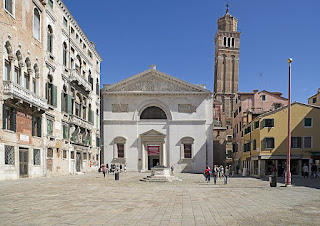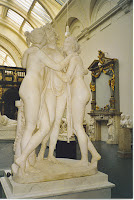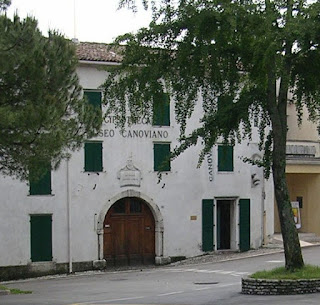Roman collectors called him the ‘new Canova’
 |
| Benzoni's self-portrait bust is in the Biblioteca Angelo Mai in Bergamo |
Benzoni sculpted many allegorical and mythological scenes, but also busts and funerary monuments.
Songavazzo being just outside Clusone in the province of Bergamo, Benzoni was regarded as a bergamasco - a native of the ancient city - even though he spent much of his life in Rome.
As such he was held in similar regard to celebrated bergamaschi such as the composer Gaetano Donizetti, the philologist Cardinal Angelo Mai and the painter Francesco Coghetti, all of whom lived in Rome during Benzoni’s time there.
He was later commissioned to sculpt a monumental tomb for Cardinal Mai in the Basilica of Sant’Anastasia al Palatino in the centre of Rome.
Benzoni’s parents, Giuseppe and Margherita, were farmers of modest means. Giovanni Maria worked briefly as a shepherd, but his father died when he was around 11 years old, after which he was sent to work in his uncle’s small carpentry shop at Riva di Solto, on the western shore of Lago d’Iseo, about 25km (16 miles) away.
 |
| Benzoni's Flight from Pompeii is notable for its extraordinary realism |
Tadini asked Benzoni to make a copy of the Stele Tadini, the sculpture made for him by Antonio Canova in memory of the count’s son Faustino, who had died at a young age.
He was so impressed by Benzoni’s attention to detail and the accuracy of the reproduction that he arranged for the young man, who had never had a formal education, to attend a college in Lovere.
When he reached the age of 18 or 19, Tadini took Benzoni to Rome, where he would work in the workshop of Giuseppe Fabris - an artist who would later became director general of the Vatican museums - and attend the prestigious Accademia di San Luca, where his fees were paid by Count Tadini.
Benzoni’s elegant marble sculptures had echoes of Canova’s work, which he greatly admired. One of his earliest pieces sculpted at the Academy, entitled Silent Love, attracted the approval of wealthy buyers in Rome, who soon began to speak of him as “il novello Canova” - the new Canova.
After winning several competitions at San Luca, Benzoni began to earn money for his work and opened a small studio in Via Sant'Isidoro, in the centre of Rome, off the street now called Via Vittorio Veneto. Demand for his work grew so rapidly that he was obliged to find bigger premises, first in Via del Borghetto and later in Via del Babuino, between the Spanish Steps and Piazza del Popolo.
 |
| Benzoni's bust of his former patron, Count Luigi Tadini, in Lovere |
One of his later works, Flight from Pompeii or The Last Days of Pompeii (1868), was inspired by his visits to the Naples region in the 1850s and 1860s, when he was moved by the capacity for destruction of the volcano Vesuvius. The sculpture depicts with notable realism a man, his wife and their baby child, the man holding a cloak above his head to try to protect the trio as they seek refuge from the falling ashes.
The original was made for the wife of a wealthy New York hotelier. Among the many copies Benzoni produced, one is housed in a museum in Australia, another in the Neoclassical-style Town Hall at Todmorden, in the English county of Yorkshire.
Benzoni, who married into a noble Roman family and had six children, always lived in Rome but returned regularly to Bergamo, where he became a member of the city’s university and donated busts of famous citizens. His own self-portrait bust is in the Biblioteca Civica Angelo Mai on Piazza Vecchia in Bergamo’s mediaeval Città Alta.
He sculpted a statue of his former patron, Count Tadini, which stands on a plinth in a lakeside garden opposite the Tadini Academy in Lovere.
After his death in 1873, the popularity of Benzoni’s work declined, in common with the Neoclassical style as the newlly unified-Italy began to look forward. It has enjoyed a revival in recent years, however. Among his most famous works, his 1861 sculpture Innocenza difesa dalla fedeltà (Innocence Defended by Loyalty), which shows a young girl removing a thorn from the paw of her faithful pet dog, sold at Sotheby’s in New York in 2001 for more than $84,000 (€77,800; £66,800) and was presented as a gift to the Metropolitan Museum of Art.
 |
| The Torre dell'orologio is one of several notable buildings in the town of Clusone |
Benzoni’s birthplace, Songavazzo, is just outside the town of Clusone, about 35km (22 miles) northeast of Bergamo, a beautiful small town nestling on a plain against the backdrop of the Alpi Orobie - sometimes translated as the Orobic Alps - which attracts visitors all year round. Apart from its proximity to ski resorts, Clusone is famous for the frescoes that decorate some of its most significant buildings, such as the Municipio (Town Hall), the Torre dell'orologio (Clock Tower) and the Oratorio dei Disciplini (Oratory of the Disciplines), which has a macabre offering entitled The Triumph of Death. Clusone is also home to a prestigious annual jazz festival.
.jpg) |
| The Palazzo Tadini in Lovere on Lago d'Iseo is home of the Accademia di Belle Arti Tadini |
Lovere, where Benzoni received his first formal education, is the largest town on the western shore of Lago d’Iseo and has wonderful views of the top of the lake with its dramatic backdrop of mountains. Benzoni’s patron, Count Luigi Tadini of Crema, established the Accademia di Belle Arti Tadini in the lakefront Palazzo Tadini in 1829 and it has become one of the most important art galleries in Italy. The church of Santa Maria in Valvendra has some 16th century frescoes and the church of San Giorgio, which is built into a mediaeval tower, contains an important work by Palma il Giovane. A pleasant boat ride connects Lovere with Pisogne on the eastern shore of the lake, which has a railway line linking the lake with the city of Brescia. The landing stage adjoins Piazza XIII Martiri.
Also on this day:
1665: The death of painter and printmaker Elisabetta Sirani
1909: The birth of Lamberto Maggiorani, star of classic movie Bicycle Thieves
1938: The birth of journalist and talk show host Maurizio Costanza




.jpg)








